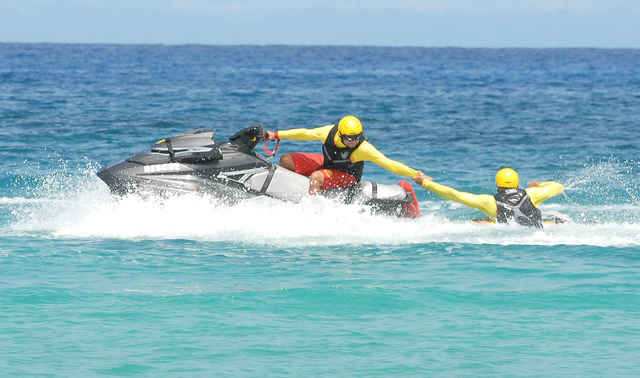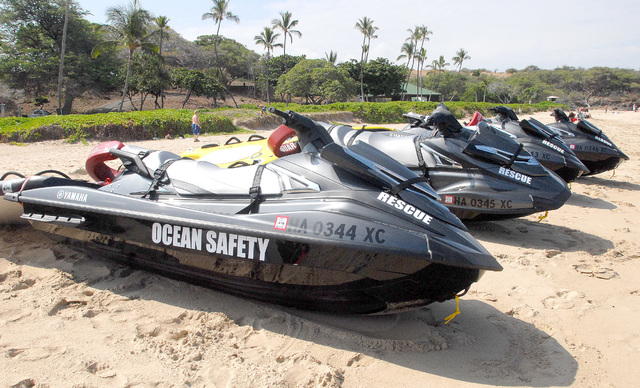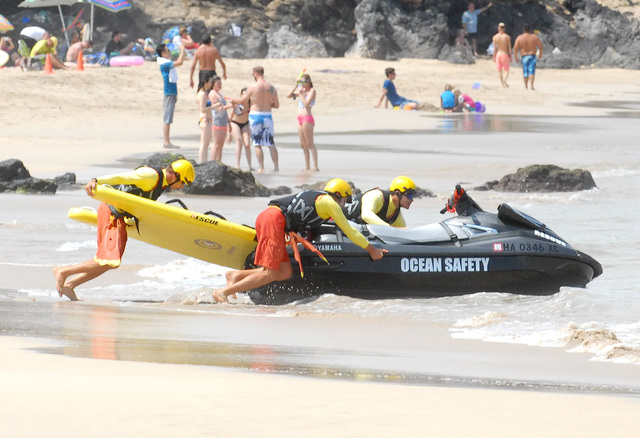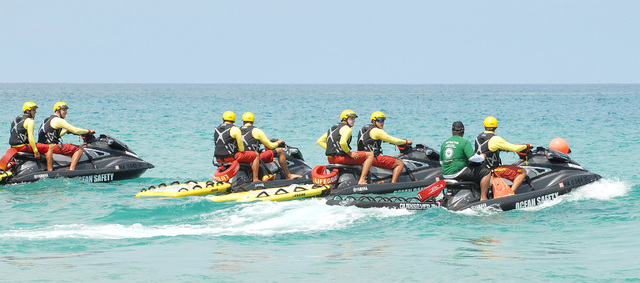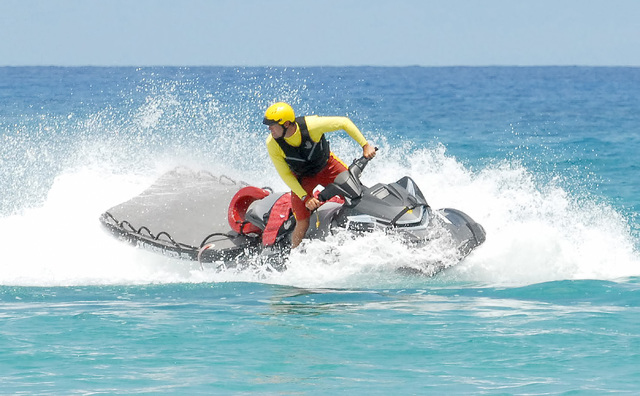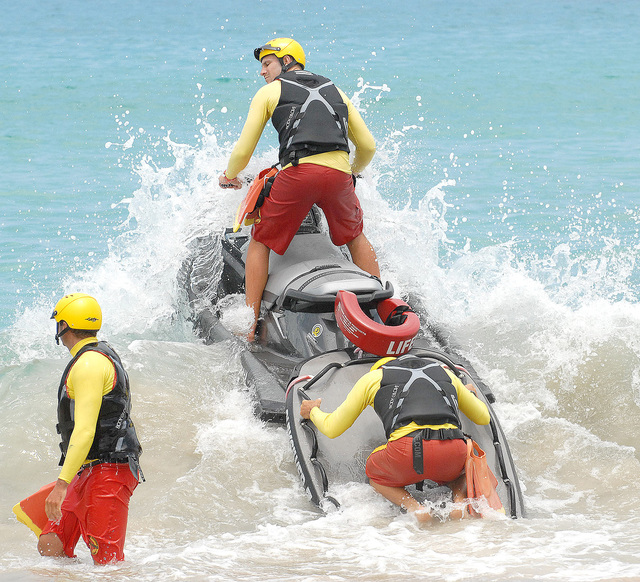A faster response: Watercraft expected to make rescues easier, quicker
When Hurricane Ana brushed south of the Big Island last October, there wasn’t much effect from winds. There was, however, an epic swell that lumbered in, plastering south-facing shores with walls of water.
At Pohoiki in lower Puna — and elsewhere — wave hunters were out in force. While the dark troughs were awesome for surfers willing to take their lives in their hands, they weren’t such a good thing for the lifeguards who had to swim out through the surf to rescue the imperiled.
Equipped only with a rescue tube, ocean safety officers threaded the lines of breakers like human seals, grappling numerous wave riders and swimmers back to safety.
For years, that’s just how big-water rescues have been done on the Big Island. But starting this summer, it could all begin to change.
The Hawaii County Fire Department this week is wrapping up a five-week training in which ocean safety officers are learning to use rescue watercraft — commonly called Jet Skis — to save lives here. Fire officials plan to have the watercraft deployed on two beaches — Hapuna and Pohoiki — in time for this summer’s hurricane season and the peak water recreation time.
“We were talking about this for years,” said Special Operations Battalion Chief Gerald Kosaki. “We never thought it could materialize because of the cost factor.”
Lifeguards on Oahu and the other islands in the state have known for years the advantages of speed and horsepower as they used personal watercraft to whip in and out danger zones, using rescue sleds to tow people out of the surf. Dogged by lack of funding, Hawaii County had no rescue watercraft of its own.
In early 2014, Kosaki and Mayor Billy Kenoi had a conversation about what it would take to bring the watercraft to the Big Island. Kosaki told the mayor the stumbling block had always been money. So last year, $320,000 was plugged into the Ocean Safety Division operating budget to launch the service.
Wednesday, two big-wave legends from Oahu’s North Shore were at Hapuna Beach to show local lifeguards how to harness the potential of the machines. The instructors leading the training included Terry Ahue, who served as a lifeguard with legend Eddie Aikau at Waimea Bay; big-wave rider Brian Keaulana, son of Richard “Buffalo” Keaulana; and lifeguard and stuntman Melvin Puu. The group pioneered big-wave rescues using personal watercraft on the North Shore in the late 1980s.
After Keaulani was almost pounded into the rocks of Waimea Bay in 1987 during the big-wave invitational in Aikau’s honor, Puu began to tinker with attaching a boogie board to a WaveRunner. A lot of trail and error followed. Puu and his cohort began to lay the framework for what is now the rescue watercraft protocol, which Puu teaches around the world.
“There was no book on this,” he said.
The sled allows the lifeguard riding astern to have a stable platform where he can begin chest compressions or other preliminary medical response, Puu said. The driver is free to focus on snap decisions.
“These guys are all risk managers,” Kosaki said. “They need to make split-second decisions if they want to go into the impact zone and make a rescue, or wait for the next wave.”
Both lifeguards must know how to drive in case the driver is knocked off. As part of the training, they must learn to deal with being swamped and overturned, and figure out how to right themselves. Tuesday, the group practiced grabbing patients in the surf and breaking through five to six-foot faces off of Honokohau Harbor.
As Puu watched from the shore at Hapuna, seven hand-picked lifeguards from both sides of the island practiced driving up on a simulated patient in the water, stopping on a dime and turning around while the lifeguard in back dove, pulled the man from eight to 10 feet beneath the water’s surface, and shoved him onto the rescue sled.
“That’s great time right there,” Puu said. “They’ve got it down to about five seconds.”
In the past weeks, Puu has watched the lifeguards go from lacking confidence and control of the machines to performing surface rescues, submerged rescues and other maneuvers with increasing speed and skill.
“These guys have told me, at two weeks, they were just scratching the surface,” said Puu, who is the rescue trainer for the City and County of Honolulu. “By week three they had it but they sucked at it. By the fourth week they start to get it. And by the fifth week I don’t tell them that much, because once we leave, they’re on their own.”
Hunter Henkel, a lifeguard at Pohoiki, stood soaked on Hapuna Beach after a training run on Wednesday. The machines will greatly expand the area lifeguards are able to cover, allowing them to respond not just to snorkelers, swimmers, surfers and near-shore problems but also overturned vessels, he said.
“It’s just gonna cut the time down by about 95 percent,” he said.
The watercraft are mounted on a double trailer, which allows ocean safety officers to have a backup machine on site in case a breakdown or other emergency puts one watercraft out of commission. The machines will be stored at local fire stations during the night and can be deployed to any beach where ocean safety officers deem their use will be most beneficial, Kosaki said.
Lifeguard Paul Tucker, who helped bring ashore Kansas doctor Ken Grasing after he was bitten by a tiger shark in March, said that in his 14 years working at Hapuna Beach, rescues have all been done with tubes and boards. Old school style.
“When the surf is big, you’re swimming with your tube and your fins,” he said, “and your partner to back you up.”
Had it occurred farther offshore, the attack on Grasing would have been a good example of how the rescue watercraft will be beneficial. Grasing left a blood trail as he was helped ashore from an area four feet deep, with an aggressive shark still circling in the water behind him. Rescue watercraft will be able to pluck a shark attack victim quickly out of an area without risking additional attacks on rescuing lifeguards, Puu said.
Fire officials are creating a plan for how far the watercraft can respond and a map of shore locations where they can most quickly meet emergency vehicles.
The lifeguards could have been certified using a shorter training, but Kosaki said the 200-hour training was chosen to give them every advantage possible.
“We wanted to make sure our guys are safe, and that they have the right equipment when they’re saving lives,” Kosaki said.
There are six rescue watercraft units on Oahu, but the island could use 12, Puu said. Two is a start for an island as big as this one, and it’s high time the machines were here, he said.
“Right now they’re starting off small,” he said. “Hopefully in the future they can expand.”


